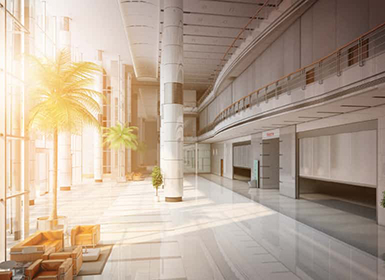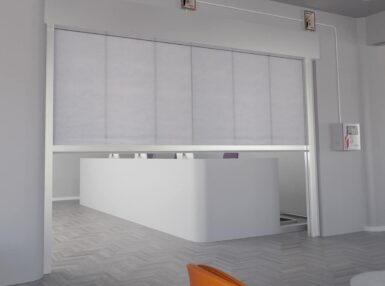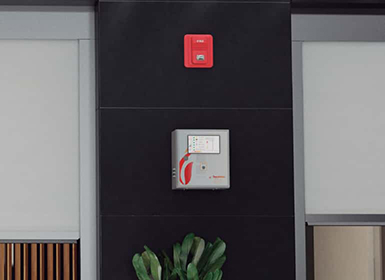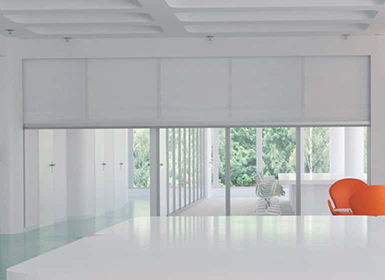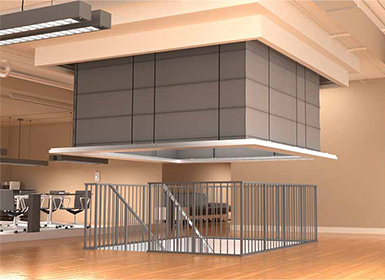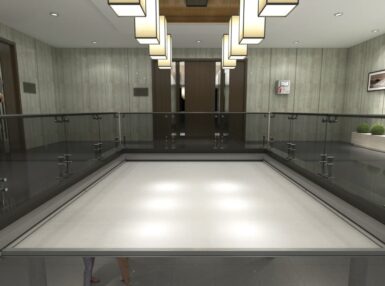Fire Curtains
Advanced Protection Systems for Fire Safety and Compartmentalisation
Fire curtains are advanced, automated textile systems specifically designed for compartmentalisation and sectorisation in the event of a fire. These fire barriers ensure the integrity and safety of your space by preventing the spread of flames and smoke. Tecnitex fire curtains provide reliable low radiation and thermal isolation, offering a high level of protection for both residential and commercial buildings.Functions and uses
Fire curtains are essential components in fire protection systems, designed to prevent the spread of flames and smoke between adjoining sectors in the event of a fire. By creating effective compartments, fire curtains ensure that fire hazards are contained within the affected area, providing vital protection to other sections of the building. Their purpose is to stop the movement of heat, smoke, and flames, safeguarding both people and property from the devastating effects of fire.
Fire Curtain Systems
Advantages
Architectural
- Light, compact system.
- Allows the creation of hidden divisions for splitting buildings, industrial warehouses, refrigerated chambers, etc. into fire sectors.
- This is an ideal solution for sectorisation in areas where there is a need for movement of machinery, people, vehicles, or conveyor belts, allowing spaces to be kept open.
- Control of production in the factory.
- Autonomous system with remote management and control of fires (depending on model).
- System for controlling lowering and FAIL SAFE controlled emergency drop integrated in motor.
- Speed of lowering in accordance with ASB1 – ASB3.
Aesthetic
- Invisible system for the compartmentalisation of fire and smoke.
- Integration and consistency with architectural elements.
- Creation of sectors, after the activation of the system by the fire protection unit.
- Finished in choice of RAL colours.
- High temperature resistance (1000ºC) under regulation EN 1634-1.
- Over 1,000 operation cycles.
- Non-penetrable by smoke with pressure of 25 Pa (0.00 m3/h).
Functional
- Easy installation and maintenance.
- Pre-assembled systems.
- Control of system status, management of maintenance and system lifespan.
- UPS uninterruptible power supply with autonomy of up to 6 hours.
- Control of position and status of the barriers.
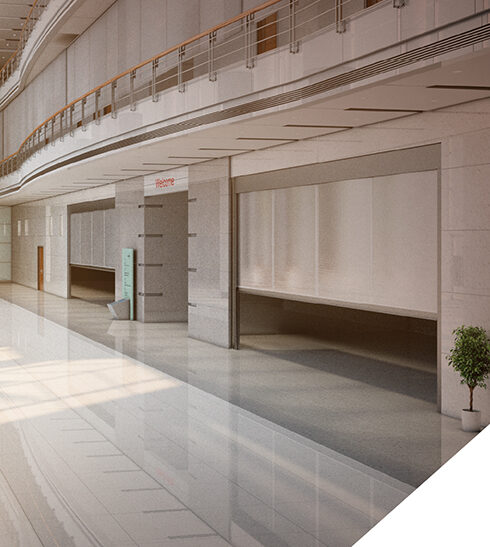
APPROVALS
EN 1634-1
Fire doors and barriers:
Defines the fire testing procedure of the systems to ensure they meet strict fire resistance standards.
EN 13501-2
Classification based on the behaviour of construction products and building elements against fire. Part 2: Classification based on data obtained from fire resistance tests excluding ventilation installations. This standard classifies systems based on their behaviour against fire, ensuring reliability in fire safety applications.
EN 15269-11
Extension of fire resistance results for fire curtains.
This standard outlines the extrapolation of fire curtains with dimensions greater than those tested, allowing for scalable fire protection solutions.
TECHNICAL EVALUATION REPORT ON SUITABILITY
This report specifies the final characteristics of the system in a single document, detailing the various tests carried out, installation placements, maximum dimensions, and the intended use of the system, ensuring compliance with all relevant fire safety standards.
Parts list
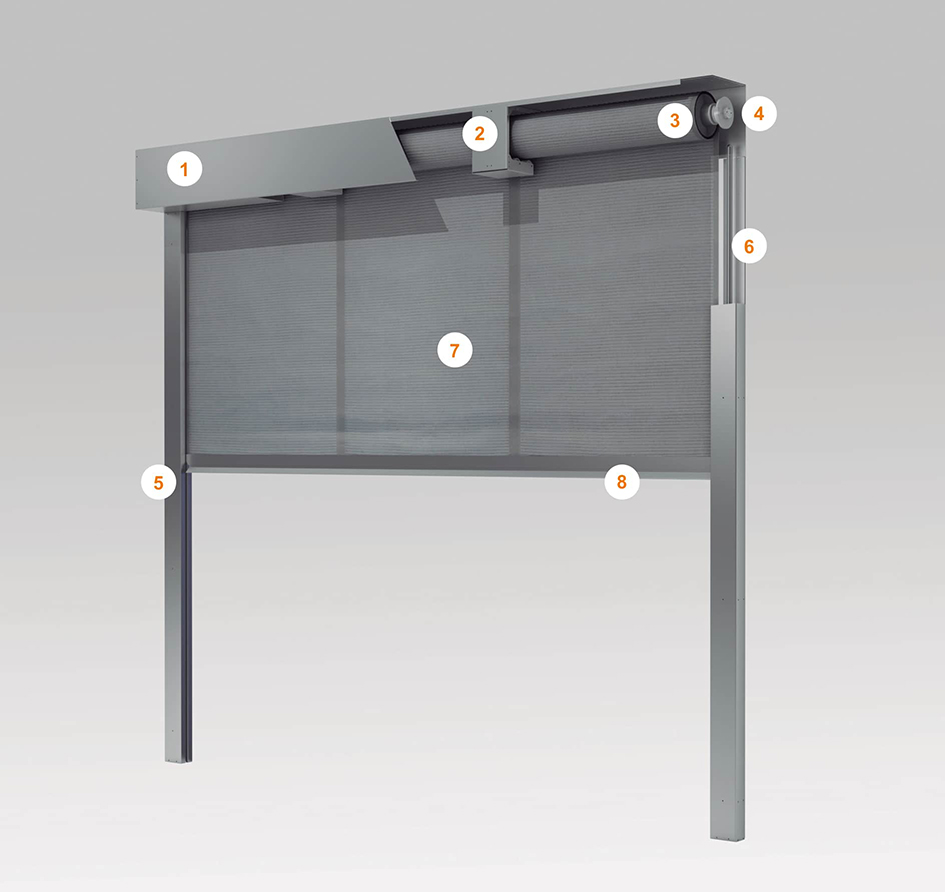
Parts list
- 1Housing – Made from galvanized sheet metal, tailored to the specific model.
- 2Removable supports – Designed to hold the roller and form the box (depending on the model). Openings are constructed with rounded edges to ensure safety and ease of installation.
- 3Roller – Equipped with an ogive to facilitate the smooth rolling of the textile.
- 4SMK motor – Features “TGFS” (Total Gravity Controlled Fail Safe Solution) technology, depending on the model, ensuring safe and efficient operation.
- 5Lateral guides – These guides feature a fabric-holding system running along the entire vertical side of the curtain.
- 6Textile holding system – Ensures the textile is securely held along the full vertical side for proper fire and smoke isolation.
- 7Technical fiberglass textile – Available in various finishes, chosen based on the model and classification of the system.
- 8Counterweight – Offered in various finishes and sizes for optimal adaptation to the box or suspended ceilings.
List of applications
Additional information on our Fire Curtains
What is a fire curtain and how does it work?
Fire curtains are passive fire protection systems designed to prevent the spread of fire between different areas of a building. These systems are made from materials that can withstand high temperatures and automatically deploy in the event of a fire, creating a barrier that limits the expansion of flames.
Fire curtains operate through an automated system that detects fire using smoke or heat sensors, triggering the curtain to unroll from its housing in the ceiling or wall. These flexible, fire-resistant curtains provide protection for large areas without requiring rigid, permanent elements like fire doors.
In what types of buildings is it mandatory to install fire curtains?
Fire curtains are mandatory in various building types where fire protection regulations require the sectorisation of spaces to prevent the rapid spread of fire. Common locations where fire curtains are required include:
– Shopping centres and large commercial spaces
– Hotels and public buildings
– Underground parking garages
– Hospitals and healthcare centres
– Office buildings and skyscrapers
Each country and region has specific regulations that determine the mandatory installation of fire curtains, so it’s essential to consult local laws to ensure compliance.
What is the difference between a fire curtain and other fire protection systems, such as fire doors?
While both fire curtains and fire doors aim to limit the spread of fire, their operation and applications differ:
– Fire curtains are flexible and deploy from the ceiling or wall only when necessary. This saves space and preserves the environment’s design without permanent visual interruptions.
– Fire doors are rigid structures that are permanently installed, which may affect space distribution and architectural design.
One of the main advantages of fire curtains is that they can protect large open areas where it would be impossible to install conventional doors, such as in lobbies, wide corridors, or shopping centre entrances.
What standards do Tecnitex fire curtains comply with?
Tecnitex’s fire curtains are designed to meet the strictest fire protection standards, both nationally and internationally. Some of the key standards we comply with include:
– UNE EN 1634-1: European certification ensuring the fire resistance of fire curtains.
– UNE EN 12101-1: Regulation related to smoke control and safety in case of fire.
These certifications guarantee that our fire curtains have undergone rigorous tests to provide maximum safety during emergency situations.
How are fire curtains installed and how long does the installation take?
The installation of fire curtains depends on the type of project and the size of the area to be protected. The general installation process includes:
1 – A preliminary site assessment by our team of engineers.
2 – Installation of the suspension systems and curtains in the ceiling or wall.
3 – Integration of fire detection and control systems for automatic deployment.
Installation time varies depending on the project’s complexity, but in many cases, it can be completed within one or two business days, ensuring the system is operational immediately.
What maintenance do fire curtains require?
To ensure optimal performance, fire curtains should undergo regular preventive maintenance. This includes:
– Visual inspections to check the condition of the curtains and their suspension systems.
– Functional tests to ensure proper deployment and retraction.
– Review of the fire detection and automation systems that activate the curtain.
Tecnitex offers specialized maintenance services tailored to each client’s needs, ensuring the curtains are in perfect condition and ready to operate in case of an emergency.
What are the advantages of using Tecnitex fire curtains?
Tecnitex fire curtains stand out in the market due to their multiple advantages:
– High fire resistance, certified under strict European standards.
– Flexible design, allowing the protection of large areas without disrupting the flow of people or affecting the aesthetics of the environment.
– Space efficiency, as they don’t require rigid structures and only deploy in case of an emergency.
– Simple and low-cost maintenance compared to other fire protection systems.
– Personalized advice and continuous technical support.
– These features make our fire curtains a reliable and efficient solution for all types of buildings.
Can fire curtains be customized according to the client’s needs?
At Tecnitex, we offer customized solutions tailored to the specific needs of each project. Our fire curtains can be customized in:
– Size and dimensions to suit the area to be covered.
– Aesthetic finishes to better integrate with the architectural design.
– Control systems, either automated or manual, depending on the client’s requirements.
Additionally, we work closely with engineers and architects to ensure the curtains integrate optimally into each project, complying with all current regulations.
